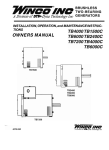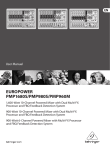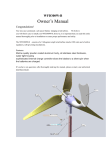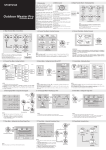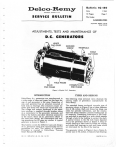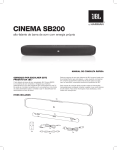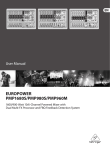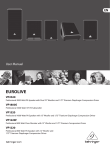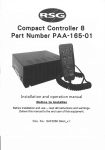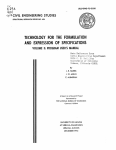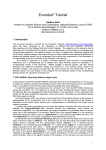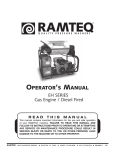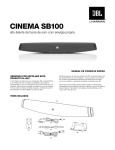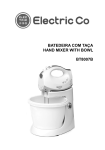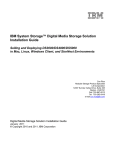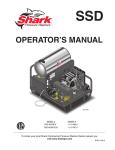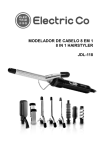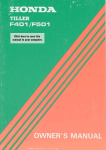Download 60706-097 Operators Manual 2FSM2PC-1/A
Transcript
INSTALLATION, OPERATION, and MAINTENANCE INSTRUCTIONS READ INSTRUCTIONS CAREFULLY BEFORE ATTEMPTING TO OPERATE OR SERVICE THE DAYTON GENERATOR. FAILURE TO COMPLY WITH INSTRUCTIONS COULD RESULT IN PERSONAL INJURY AND/OR PROPERTY DAMAGE! RETAIN INSTRUCTIONS FOR FUTURE REFERENCE. Unpacking Testing Policy Before any generator is shipped from the factory it is fully checked for performance. The generator is loaded to ~ t sfull capacity, and the voltage, current, and frequenc are carefully checked. A test card with this data is file by unit serial number for permanent record of performance. Rated output of generators is based on factory tests of typical units, and is subject to and limited by the ambient operating temperature. The generator will not provide full power output unless driven by a prime mover of adequate horsepower. The prime mover (engine or other input power source) horsepower is also affected by temperature as well as a number of other factors such as fuel, altitude and all other conditions specified by the prime mover manufacturer. d Description The WlNCO generator is a 3600 RPM two bearing, belt driven, brush type, revolving armature design. The generator is self excited and inherently regulated to +/- (plus or minus) 7% - no load to full rated load. It can be operated under any load within its rating without being damaged. The frequency regulator is determined by the sensitivity of the customer supplied prime movers' governor. It is desirable to maintain this speed to within 3 cycles variation (61.5 Hz - 58.5 Hz) no load to full rated load (3690 RPM - 3510 RPM). Specifications 1 2,000 PH VOLTS AMPS HZ WkrrS 1 120 1 16.7 ( 60 1 RPM INSULATION 1 136001Class B I When unpacking the generator, be sure to inspect it carefully for freight loss or damage. If loss or damage is noted at the time of delivery, require that the person making the delivery make note of the loss or damage on the freight bill, or affix his signature under the consigner's memo of the loss or damage. Contact the carrier for claim procedures. When loss or damage is noted after delivery, segregate the damaged material, and contact the carrier for claim procedures. "Concealed damage" is understoodto mean damage to the contents of a packagewhich is not in evidence at the time of delivery by the carrier, but which is discovered later. The carrier or carriers are responsible for merchandise lost or damaged in transit. The title of goods rests with the consignee when generators are shipped FOB factory. And only the consignee can legally file claims. 1. Carefully open carton. 2. After inspecting the generator for external physical damage, check for the owner's manual (operating instructions, wiring diagram, parts list, and warranty) inside the carton. 3. Remove generator hold down bolts. 4. Unit can now be lifted from shipping base. General Safety Information DEFINITION OF CAUTIONS AND WARNINGS CAUTION: Possible damage to equipment. Notes indicate any condition or practice, which if not strictly observed or remedied, could result in damage or destruction of the equipment. WARNING: PERSONAL DANGER. NOTES INDICATE ANY CONDITION OR PRACTICE, WHICH IF NOT STRICTLY OBSERVED, COULD RESULT IN PERSONAL INJURY OR POSSIBLE LOSS OF LIFE. Despite the safe design of this generator, operating it imprudently, neglecting its maintenance, or being careless with it can cause serious injury or death. This generator is powerful enough to deliver a fatal electric shock. Allow only a responsible and capable person to operate this generator. 1. For permanent wiring or wiring into existing electrical service or system, the installation must comply with all national, state and local codes. 2. Do not allow anyone to operate the generator without proper instruction. 3. Avoid touching live terminals or receptacles. I General Safety Information (Cont'd) 4. Be extremely careful if operating this generator in rain or snow. 5. This generator must be properly grounded. 6. Hot prime mover (engine) parts, movingdrive parts, and generator output, all can seriously injure the generator operator. The operator must use caution and remain alert when using this generator. 7. Keep all safety guards and drive shields in position and tightly secured while equipment is operating. 8. When operating this generator, do not wear neckties, loose articles of clothing or anything else that can be caught in moving parts. 9 Provide adequate ventilation for prime mover exhaust and fuel vapors that may leak through fittings or damaged pipes. Be sure generator itself is well ventilated for maximum performance and life. 10. The generator manufacturer recommendsthat only qualified electrical technicians be allowed to service (install, maintain, repair, or replace parts) this generator, and that only factory approved repair parts be used in it. 11. Do not work on this generator (or other potentially hazardous equipment) when fatigued. 12. Use extreme caution when working on electrical components. High generator output voltage can cause serious injury or death. 13. Keep the generator and the area around it clean. Remove all material that can create slippery conditions, such as grease, water, ice and snow. Also remove oily rags and other flammable materialfrom the area. 14. Keep a fire extinguisher near the generator. Extinuishers rated ABC by the NFPA are appropriate or this use. Consult the local fire department if you have questions regarding fire extinguisher ratings. Keep the extinguisher properly maintained and be familiar with its proper use. 9 Installation CAUTION: Before proceeding with the installation, be sure that you have completely read and understood the assembly and installation instructions. An engine with adequate horsepower and a close regulating (fixed speed) governor is required for satisfactory operation of any alternating current generator. About 1.4 horsepower is required to produce each 1000 watts of generator output power assuming 10O0/0 efficiency of both the engine and the generator. However, due to engine and generator efficiencies of 80 to 9O0/0, the loss of power due to engine driving accessories such as cooling fans, battery charging alternators, etc., friction losses and slippage in the drive pullies and belts, the general conservative rule of thumb allowing approximately two (2) horsepower for every 1000 watts of generator output is much more realistic. For example, this 2.000 watt generator output will require a 4 or 5 H.P. engine for full output, good speed/voltage regulation, and satisfactory load performance. When determining the prime mover/generator pulley ratio to drive the generator at the correct operating speed. bear in mind that the power rating of most prime movers (usually an engine) varies with the speed - that is. it produces more power at higher speeds, less when slowed. The prime mover must be run fast enough -to reach the desired horsepower for good gemrator set operation. The drive belt system must be of adequate size and must be tight enough to power the generator without slippage. Be careful not to overtighten to the extent that it puts excessive strain on the bearings - doing so can cause bearing failure and other possible damage to the generator. Alignment of the generator to the prime mover is important. Misalignment of the pullies will cause excessive belt and pulley wear and unnecessary stress on the prime mover. The following table shows the effect of various operating speeds and electrical loads on a typical generator when matched and mounted to an adequate prime mover. The following table shows the effect of various operating speeds and electrical loads on a typical generator when matched and mounted to an adequate prime mover. Although individual units and models may vary slightly, the normal voltage and frequency of typical 60 cycle engine-driven generators described in this manual are approximately as follows when powered by a typical prime mover (engine) run first with no load applied, then at half the generator capacity and finally when loaded to its full capacity as rated on the nameplate. GENERATOR LOAD None Half Full SPEED FREQUENCY 3690 RPM 61-1/2 Hz 3600 RPM 60 Hz 13510RPM I 58-1/2Hz VOLTAGE I 129 Volts 120 Volts 115Volts I NOTE: Required generator speed must be maintained at 3600 + / - 90 RPM under all load conditions. All engines have a tendency to slow down when a load is applied. The governor on the engine is designed to hold the engine speed nearly constant. When the electrical load connected to the generator is increased, the engine is more heavily loaded and as a resu't the speed drops slightly. This slight decrease in spesd together with the natural "voltage drop" within the generator itself due to load current and heating of the windings, results in a slightly lower voltage than when the generator is running idle. The normal slight variations in speed also directly affect the frequency of the output current. This frequency variation has no appreciable effect in the operation of most loads (such as motors, lights and most small appliances). However, timing devices and clocks will not keep perfect time unless the engine can keep the enerator running at exactly 3600 RPM at all times. ince this is not usually possible, mrnor time errors in clocks occur. The speed of the engine is usually adjusted so that the generator produces proper voltage. If the adjustment is made "cold," set the voltage a little higher than normal since it will drop a few volts as the generator warms up. NOTE: When operating continuously at full load the enerator shell becomes very warm. It will be uncomortable to the touch - this is normal for any high performance inherently regulated generator. Output voltage should be checked periodically to ensure proper operation of the generating plant and appliances. CAUTION: Low voltage may damage any motors or appliances connected to it. Running the generator at excessively high speeds results in too high voltage which will also damage electrical devices connected to it. Excessively high speed may also cause damage to the generator armature windings. 8 9 residual voltage level (nearly zero - typically 3 to 7 volts). The exciter voltage is also taken from. the generator ouptut voltage. Since there is no exciter voltage, the generator magnetic field 'collapses'. Now thefe is virtually no load on the generator or engine, so no harm is done to either. Under these conditionsi the motor may revolve a few times when it is first turned on, and then stop when the generator field collapses under massive overloads. The generator is self or inherently protected and since the generator is producing nearly zero voltage, the motor or other load is not damaged in any way. CAUTION: On the other hand, an electric motor that requires slightly more output than the generator can produce will run, but will not reach a high enough speed for the centrifugal switch to disconnect the starting winding. The generator output voltage, instead of being 115, may drop t o 70 or 80 volts. Running the generator under these conditions may result in burning out the motor start winding. Exercise care the first time each new load is energized to be sure that the load is compatible and within the capacity of the generator. Because the heavy surge of, current required for starting motors is required for only an instant, the generator will not be damaged if it can bring the motor up to speed in a few seconds of time. If difficulty i s experienced in starting motors, turn off all other electrical loads and, if possible, reduce the load on the electric motor. Assembly (Continued) Plans for installation should be prepared with proper attention to mechanical and electrical engineering detail to assure a satisfactory system installation. The information in this manual is offered as a guide to finalizing your installation plans. The installation sequence is summarized below. PLAN THE INSTALLATION Generally these two-bearing generators are used on portable equipment. For best service consider the following: 1. All electrical equipment should be protected from excessive moisture. Failure to do so will result in deterioration of the insulation and short circuits and grounds. 2. The generator should be installed in a sheltered area. If the unit must be left in the open it should always be protected with a weather cover such as a tarp or large piece of canvas after each use to keep out water and dust. CAUTION: Always a l l ~ wthe generator and prime mover to cool before covering with a flammable weather covering. MOUNTING CAUTION: The generator must be mounted with the engine to a common rigid base to prevent stress on the engine and generator shafts and bearings due t o vibration displacement. For permanent installations, the engine-generator is usually mounted on a sub-frame which can be shock mounted with special neoprene pads on the main frame. Maintenance GENERAL The main components of the generator are: field frame, field coils, armature, brushes. brush holder assemblv.. brackets, armature, and generator cooling fan. Operation . USE OF ELECTRIC MOTORS Electric motors reauire much more current [am~ereslto help start them ihan to run them. ~ e r i a i nmotors, ' articularly inexpensive split-phase motors are very ard to start. Typically, they require 7 to 10 times as much current to start them as to run them. Capacitor motors are easier to start but still require 3 to 5 times their running current to start. Repulsion induction motors are the easiest to start and usually require only 2 to 4 times their running current to start. Refer to the nameplate of the generator for the running current (ampere rating) and starting code of your motors. NOTE: The starting code is an alpha character - 'A' code motors are the easiest to start; 'R', 'S', or 'T' code motors are very hard starting. Most fractional horsepower motors take about the same amount of current to run them regardless of their type of construction (repulsion-induction (RI), capacitor (CAP), or split-phase (SP) type). A self-excited generator responds differently to severe overloading than a transformer connected to a power line. To illustrate, suppose that a 115 volt 5 H.P. "capac~torstart-induct~onrun" motor is connected to a small transformer with a maximum rating of 2,000 watts and then to a generator of 2,000 watts capacity. The transformer would not be able to supply enough power to bring the motor up to operating speed, but would be very severely overloaded and probably would burn out in a short time. The motor might also be damaged. When this motor is connected to a self-excited 2,000 watt generator, the generator output voltage drops to its BRUSHES Under ordinary circumstances brushes will operate for thousands of hours without requiring replacement. They should be inspected after the'first 1000 hours of operation, and after every 500 hours of operation thereafter. Remove brushes one at a time and check for length. Be sure that each moves freely in the brush holder. Brushes should be replaced whenworn down to 3/8". Always replace brushes in complete sets, never singly. When replacing brushes be careful to reconnect the lead wire properly. Poor contact or "skipping" between brush and slip ring can be caused by oil and grit, flint, or other hard contaminant substances on the brushes, or by the brush not being properly shaped to fit the slip rings. . . Remedy these defects by cleaning the iings and brushes and then fitting the brqshes to the slip-ring curvature. Place #00 sandpaper under the brushes with the abrasive side to the brushes, and workit back and forth until the brushes are the same shape as the sliprings. SLIP RINGS The continuous copper rings located at the end of the .armature are the power collector rings or 'slip rings.' For proper generator output, the surface of these slip rings must have a highly polished finish. Under sustained use, it is advisable to check and occasionally polish the ring surfaces with a crocus cloth to maintain the finish under normal conditions. This should not be required more than once each thousand hours of operation. C p -3- Maintenance (Continued) ELECTRICAL TESTING Testing generator field for opens and grounds. 1. Disconnect field lead from rectifier. 2. Set multimeter to read resistance, and connect the meter leads to the field leads. If field is open, meter will read infinite resistance (very high ohms). Repair or replace field if it is open. Typical resistance for these fields vary from 12.8 to 14.1 ohms. 3. Leaving one meter lead connected to the field, connect the other meter lead to the field shell. If meter indicates continuity (any reading- should be infinite resistance). The field is grounded and should be repaired or replaced. To determine which of the fields is grounded, cut the connector between the two coils and retest to determine which coil has the low resistance path. 3. Testing for opens Set meter to read low resistance (R x 1 ohms). Holding one meter lead on surface of slip ring No. 1, touch other meter lead to surface of slip ring No. 2 while observing the meter. Meter should indicate continuity (low resistance - less than one ohm is typical). If the meter indicates open circuit (infinite resistance) part of armature winding is open. This may be caused by a repairable defect in the connection at the slip ring, however generally an open armature will have to be replaced. Figure -- 3 Figure - 2 TESTING ARMATURE FOR OPENS AND C%OUNDS (See Figure 3) 1. Remove all brushes. 2. Ground fault test set multimeter to read high tesistance (meg-ohms). Holding one meter lead against a clean spot on the armature shaft, touch the other lead to each of the slip rings (one at a time) while observing the meter. If meter Indicates continuity (any reading lower than one meg-ohm), the armature IS grounded. Dirt between the slip rings and on the insulator surface can cause grounding. If grounding was indicated, carefully clean all dirt off the slip rings and their insulators and then recheck it. Replace the armature if ~tis grounded and unrepairable. - -4- TESTING RECTIFIERS (See Figure 4) The field excitation is supplied through a half wave bridge rectifier. This type of rectifier has three terminals -two AC, and a DC positive. A rectifier may be tested in the following manner: 1. Disconnect all leads from rectifier. 2. Connect the red ohmmeter lead to the positive DC (+) terminal. 3. Connect the black lead to each of the AC terminals in turn. Either a high or low resistance reading will be obtained. 4. Reverse the meter leads, (black lead to the pas (+) and red to the AC terminals, each in turn. An opposite reading should be observed. 5. Check each terminal to the Case. An Open circuit (very high resistance) reading should be observed. A battery powered test light is used. Follow the same procedures described above. A good diode element will allow current to pass to the light in the test lamp when the leads are connected in the forward direction. 6. If the rectifier falls any of the above tests, it should be considered defective and replaced. Maintenance (Continued) CONDENSER TESTING Condensers are built into the generator circuit t o ' minimize radio interference during operation. If a condenser shorts out, it will also short out the generator output. To determine whether a condenser is shorted, stop the generator and disconnect the condenser lead wire from the brush holder. Using a multimeter on the R x 100 scale, check the resistance of the condenser. Normal response is a sharp swing of the meter towards low resistance and then a steady rise towards high resistance (open circuit). If the capacitor is shorted it will show as a constant low resistance. Otherwise, restart the generator without the capacitor connected to recheck the generator for output. If the . enerator then provides power, the condenser was at ault and should be replaced. (If the generator did not provide power after the problem was not caused by that condenser, reconnect the lead wire). If these tests have not located the trouble, remove the armature and have it tested for opens, shorts, and grounds on a growler. RED (+I TEST LEAD ? Figure 4 RECEPTACLE PLATE SCHEMATIC DIAGRAM BEARING END ---ARMATURE WIRING DIAGRAM Egure 5 - Wiring Diagram -5- ILLUSTRATE PARTS LIST MODEL 2FSM2PC-1IA PART NUMBER 61685-000 REF PART NBR QTY DESCRIPTION REF PART NBR QTY DESCRIPTION 1 2 3 4 6372-000 484-000 20556-002 7924-000 4 4 4 1 #lo-32 Nut # I 0 Lockwasher # I 0-32 Thru Bolt Baffle 12 13 14 15 61687-000 60925-000 60925-001 61689-000 1 1 1 1 Field Shell & Coil Assy Upper Field Coil Lower Field Coil Field Shell 5 6 7 20557-000 40746-000 61427-000 2 6 1 Anchorstrap 16 #8-32 X 5116 Screw 17 Output End Bracket 18 23607-000 59690-000 41221-000 3 3 2 AC Brush Brush Holder Capacitor 8 9 10 11 8929-000 60928-000 61426-000 55223-000 1 1 1 2 Input End Bracket 19 Cover 20 Armature wlBearings 21 Bearing 22 91452-000 59688-000 60960-000 60931-000 I 3 2 1 Rectifier Barrier Spacer Receptacle Receptacle Plate L( SYMPTOM No output or low output voltage Troubleshooting Chart POSSIBLE CAUSE@) 1. Open or shorted armature . 2. Open or shorted field coil(s) 3. Generator operating below correct RPM speed 4. Generator overloaded 5. Short circuit in the load 6. Loose (or broken) wires or connections in the control box 7. Defective rectifier 8. Dirty slip rings 9. Brushes binding in holders 10. Loss of residual magnetism Output voltage too high Generator overheating Engine speed too high 1. Generator overloaded 2. Armature rubbing pole shoes 3. Poor ventilation 4. Short circuit in fields Sparking at the brushes 5. Short turns in armature 1. Generator overloaded 2. Brushes not seated properly 3. Slip rings rough or eccentric 4. Brushes sticking in brush holder 5. Brushes worn down shorter than 318 inch CORRECTIVE ACTION 1. Replace armature. 2. Replace field coil(s). 3. Generator must be operated at 3600 RPM, +/- 90 RPM for proper output voltage. 4. Reduce load to generator nameplate. 5. Disconnect the load. Check voltage at receptacle. Check motors, appliances and load leads for short circuits. Repair short. 6. Remove panel cover and check all wiring and connections. Tighten and/or repair where necessary. 7. Test rectifier. Replace if defective. 8. Clean and polish. Use 00 sandpaper and crocus cloth, never emery paper. 9. Check brushes for swelling. Replace defective brushes. Clean brush holders. 10. Check output voltage with sensitive meter. If very low (eg. 1/2 volt) flash fields with 12 VDC'battery. See engine manual. 1. Reduce load. 2. Check bearing condition. Check field shell bearing bracket alignment. 3. Clear inlet and outlet air vents of debris. If unit is housed, ensure at least 2 ft. clearance on all sides and that inlet and outlet vents are of adequate size. 4. Repair or replace -open or shorted fields should be replaced. Grounded fields may be repaired by insulating at the point where the ground occurs. 5. Replace arm. 1. Reduce load. 2. Contour brushes (see maintenance). 3. Redress slip rings (see maintenance). 4. Remove brushes and inspect and correct problem. 5. Replace brush. NOTE: Always replace brushes a full set at a time. WINCO, Incorporated warrants to the original purchaser for 12 months that goods manufactured or supplied by it will be free from defects in workmanship and material, provided such goods are installed, operated and maintained in accordance with Winco written instructions. WINCO's sole liability, and Purchaser's sole remedy for a failure under this warranty, shall be limitedto the repair of the product. At WINCO's option, material found to be defective in material or workmanship under normal use and service will be repaired or replaced. For warranty service, return the product within 12 months from the date of purchase, transportation charges prepaid, to your nearest WlNCO Authorized Service Center or to WINCO, Inc. at Le Center Minnesota I THERE IS NO OTHER EXPRESS WARRANTY. To the extent permitted by law, any and all warranties, including those of merchantability and fitness for a particular purpose, are limited to 12 months from date of purchase. In no event is WlNCO liable for incidental or consequential damages. Note: Some states do not allow limitation on the duration of implied warranty and some states do no allow the exclusion or limitation of incidental or consequential damages, so the above limitations may not apply in every instance. This warranty gives you specific legal rights which may vary from state to state. WlNCO reserves the right to change or improve its productswithout incurringany obligations to make such changes or improvement on products purchased previously. . WlNCO does not warrant engines, batteries, or other component parts that are warranted by thier respective manufacturers. WlNCO does not warrant modifications or alterations which were not made by the WINCO, Inc. WlNCO does not warrant products which have been subjected to misuse and/or negligence or have been involved in an accident. This warranty does not includetravel time, mileage, or labor for removalor reinstallationof WlNCO product from its application. ZSSoulh Cordova St. I LE CENTER, MINNESOTA -7 Phone: (612) 3516821








